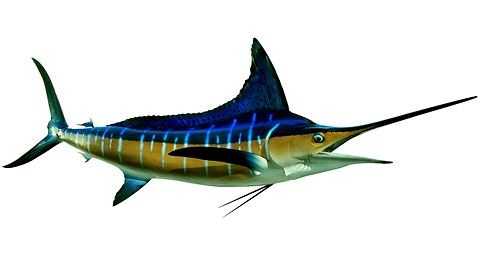Striped Marlin

Species Details
Kajikia Audax
Istiophoridae
Perciformes
Onshore
417 - 440 lbs.
137" - 165"
Striped Marlin (Kajikia Audax) Fish Description
Considered the most beautiful among the marlins, the Striped Marlins are a highly prized gamefish. They are part of the Billfish family since their upper jaw extends to what serves as a “bill” or what looks more like a spear. Striped Marlins can be differentiated from the Blue, Black, and White from the pale blue stripes that appear on its body. Even after death, the pale blue stripes will not disappear from a Striped Marlin’s body.
Striped Marlins also have a more compressed and slender body, taking a real shape of a torpedo to maximize their speed. They also have flexible pectoral fins although theirs are more pointed unlike that of the Blue Marlin which are foldable and scythe-shaped. They also have a lighter blue color which differentiates them from their Blue cousin. Their jaws are another distinct feature too. While the Blue Marlin has a short but broad lower jaw, the Striped Marlin has a narrow but pointed lower jaw. And if one were to cut them up, Blue Marlin’s have a rounded body while the Striped Marlin may look more like an egg.
Diet and Size
Striped Marlins are at the top of the food chain as apex predators. They like feasting on a school of fish such as tunas and sardines. Unlike others, however, their diets don’t seem to change much as they get older. Striped Marlins are not seen as picky eaters and do eat a variety of things. Some reports cover Striped Marlins capable of killing smaller, surface-lurking sharks.
Striped Marlins are quite big. The average size of a Striped Marlin is around 137.8 inches (11. 48 ft). They can weigh up to 440 lbs but on average weigh up to 417 lbs. It depends however where they were caught.
Interesting Facts
- Striped Marlins are considered the most beautiful among the marlins.
- Striped Marlins are often favored for their meat and are turned into sushi known as Nairagi.
- They are often confused with the Blue Marlin because of their color.
- Striped Marlins are migratory fish, similar to their other marlin cousins.
- Some say that Striped Marlins taste similar to Swordfish but have a more pronounced flavor than it.
Fishing Techniques: How to Fish for a Striped Marlin
Like any marlin, you have to treat it as an apex predator that can evade you at any given time. Like most marlins, the Striped Marlin can do a variety of acrobatics that can dazzle you but also make you lose your window of opportunity.
When looking out for them, make sure you have binoculars that can catch their movement. Don’t try to “eyeball” them because you might lose them. Some people prefer catching Striped Marlin more on a team effort rather than one because it takes time to verify them.
Next, take note of the winds. Head down sea and you’ll find them trying to cut through the waters.
As for setting up lines, there are two ways to go. One is Pelagic Long Lining where you also catch tuna, a preferred bait of the Striped Marlin. Another way is Pelagic Hook and Line. Set up several lines and scatter live bait which will attract the Skipjack Tuna. When you’ve attracted those, you’re most likely to have a Striped Marlin come your way.
Make sure you have heavy gear as well. These fish are heavy and with enough force, can break your tackle with a few strikes.
Habitat and Distribution
Some say that the best place to catch Striped Marlin is in Cabo San Lucas, Mexico. While they do migrate, the Striped Marlins usually go through the warmer parts of the ocean hence its passage through Mexico. According to some anglers, the Striped Marlins usually pass that area around February to August before fading away when the cooler weathers come in.





